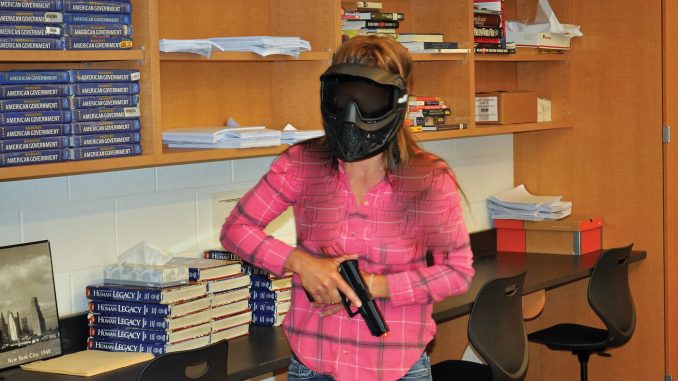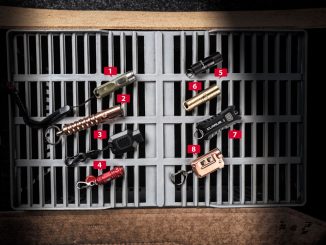
The FBI defines an “active shooter” as “one or more individuals actively engaged in killing or attempting to kill people in a populated area.” It reported 250 active-shooter incidents between 2000 and 2017. Not surprisingly, 52 of these incidents took place in schools, with 37 in pre-kindergarten through grade 12; gun-free zones in which faculty and staff are sometimes given rocks and tennis balls as their only tools to stop an active killer.
“Active killer” is the term I prefer to use instead of “active shooter.” Because I actively partake in the shooting sports, I consider myself an active shooter. From sporting clays to 3-gun—heck, even when I’m hunting—I’m an active shooter. The monsters who slaughter innocent children in schools are active killers, so that is how I will refer to them in this article.
HOW LONG IS RESPONSE TIME?
I spent many years substitute teaching while my now college-age boys were in grade school. Eventually, I earned my teaching license and taught for two years in long-term substitute teaching positions. I’ve been in many different classrooms, in numerous schools, in more than five districts.
Why is this important? My background is somewhat diverse, allowing me to bring a well-rounded view to the important topic of having armed faculty in the schools. There are many school districts, including those in my home state of Ohio, that allow faculty to be armed. Some school districts out in the country might have up to a 40-minute wait for law enforcement to show up at the school doors. They know their only hope to stop an active killer is to take matters into their own hands. Districts with a faster police arrival time know that when seconds count, law enforcement is only minutes away.
Consider this when contemplating how long it could take law enforcement to arrive at a school where there is an active killer. When the shooting begins, it has to first be identified for what it is. Then, someone has to call 911. Dispatch answers, understands the situation and relays it to law enforcement.
Police now make their way to the school. Once there, they have to enter the building, search for the killer and then end the confrontation. How long could this take? However long, I guarantee it would seem longer if it were you in the building, hiding from the killer.
“FASTER” TRAINING
Many school districts in Ohio send their staff to Faculty/ Administrator Safety Training and Emergency Response (FASTER) training. This is a course I’m proud to have been a part of since the beginning.
The FASTER program began as the vision of John Benner, owner of Tactical Defense Institute (TDI) in Ohio. Although he had been working on the concept for a while, it wasn’t until the 2012 Sandy Hook Elementary tragedy in Newtown, Connecticut, that school districts were ready to listen. Through the support of the Buckeye Firearms Association (BFA), this nonprofit program arose, giving educators practical violence response training.
In March 2013, I was part of the 24 school staff members (out of 1,200 applicants) attending the first FASTER course. The intense, three days (27 hours) of training included defensive mindset, learning about the history of active killers, firearms skills, trauma aid techniques and force-on-force scenarios.

FASTER students practice applying tourniquets, pressure-dressing and much more while learning trauma aid techniques.
Since that first FASTER course was held, more classes have been offered every year, with level-two and -three courses added.
To date, the FASTER program has trained more than 1,300 faculty members in numerous schools throughout Ohio. Some school districts there proudly advertise and post signs that they have armed staff on premises to protect their students. Others keep it a guarded secret.
Carrying a firearm in a school is not for everyone. Candidates must have the proper mindset and shooting skills. The purpose of having armed staff is not to replace police or EMTs but to have on-site personnel with the tools they need to stop active killers rapidly and render medical aid immediately.

School staff members learn shooting techniques that could someday be called on to save the lives of their students.
The following two statements are from school staff members who attended FASTER training in 2016:
“The biggest thing I learned from the course is that every district needs to have this training. This class far exceeded my expectations by putting the trainees in real-life scenarios and providing them with the training needed to handle those situations. As a U.S. Army veteran, I put this training right up there with my military instruction and consider it to be pivotal, life-changing and excellent!”
“When I came, I had no idea what to expect, but I will say, I was very nervous. As a person in administration at a school, my plan was if I can’t handle it in training, I don’t want to be the one to handle it when it’s the real thing. This class totally changed my thought process. The training I received does not just apply to our school; it applies to everyday life. I learned how to be alert and see things around me. I learned how to move swiftly and effectively through my school and how to handle the situation with a level head.“
It is a well-established fact that a faster response to active killers results in fewer lives lost. The FBI reported that between 2016 and 2017, armed and unarmed citizens engaged the killers in 10 out of 50 incidents. They safely and successfully ended the shootings in eight of those incidents. Their selfless actions likely saved many lives.

FBI report map https://www.fbi.gov/about/partnerships/office-of-partner-engagement/active-shooter-incidents-graphics
COMMITMENT TO SAVING LIVES
Not everyone who attends and successfully completes the FASTER program comes from a district that will allow them to carry. These school staff members commit to training on their own time in the hope of getting a head start when the program is implemented in the schools in which they work.
In Ohio, the decision regarding whether to arm staff is made by school districts. Because they are not required to make that information public, there are no figures about how many of the 610 districts have armed teachers.
Having the mindset and passion to want to protect children within their care is something many school staffs have. However, seeking out training, along with the tools needed to complete the mission, is not for everyone.
I commend these sheepdogs who are willing to risk their lives to stop the wolves from killing.
For more information about the FASTER program, visit the website: FASTERSavesLives.org.
About the Author
Michelle Cerino is both a firearms trainer and the president of Cerino Consulting and Training Group, LLC—a firearms training company she built with her husband, Chris, in 2011. She writes, hunts and competes in major 3-gun matches nationwide.
Editor’s note: A version of this article first appeared in the November 2018 print issue of Gun World Magazine.









Be the first to comment